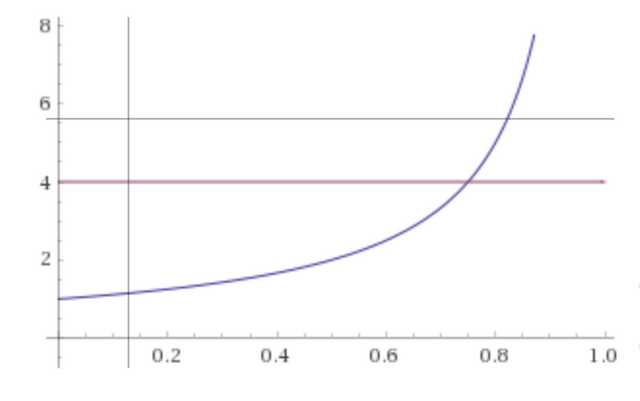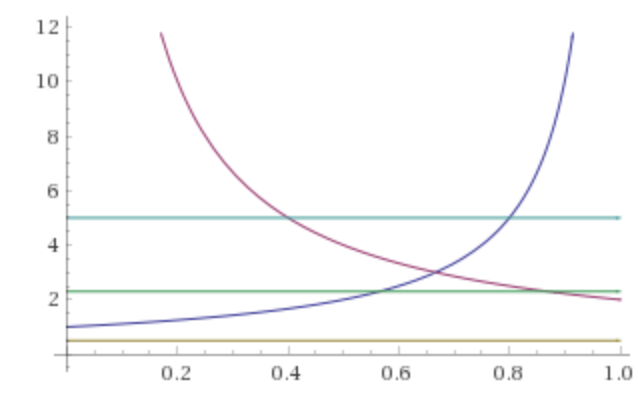Are there actually assassination markets on augur?
Augur is a decentralised prediction market platform running on the ethereum blockchain. Quickly after opening it the first bets on whether Trump will still be alive at the end of 2018 appeared. Many argue that this represents an assassination market since it creates a situation where people may obtain a financial incentive to remove Trump.
But in fact the situation is significantly more complex. Let us look at an event that naturally occurs at a probability p₀. The question is wether the existence, and actions of the participants can influence this probability.
I will label the total stake of the market as T. The cost of manipulating the probability is called M. In particular M₁(p,C) is the cost to increase the probability by 1% and M₂(1-p,C) is the cost to reduce it by 1%. These functions depend on the current probability and on the corruption of the market C = I/T, where I it the total amount of money spend on manipulating the market.
For example in the case of death predictions, M₁(p,0) at the point C=0 is the cost of hiring an assassin, while M₂(1-p,0) is the cost for better heath-care. Then once the market becomes corrupted C≈0.1, M₁(p,0.1) is the cost of better assassins and M₂(1-p,0.1) is the cost of bodyguards and emergency medical treatment.
Now it is very easy to see what happens if the stakeholders on both sides invest in these measures. The people betting on outcome 1 (or death) expect a profit of T⋅p if they do nothing and T⋅(p+0.01)-M₁(p,C) if they pay the cost to corrupt the market. Therefore interfering with the market is profitable if 0.01T>M₁(p,C). The other side 2 (or life) is profitable when 0.01T>M₂(p-1,C). Note that the actual probability p cancels in both cases and only the total stake matters.
This result is easy to understand. If the stake T is too low, then it does not pay to interfere and manipulate the market, but once the stake is large enough, then both sides may try to interfere. In order to proceed we have to analyse the shape of the functions M. While this depends a lot on the problem, it is obvious that the cost will diverge when the desired probability approaches certainty. The function will look something like this, but with some features on top

where the blue line is M and the red line is T/100. It is profitable to manipulate the probability until the two lines intersect.
But while the side 1 tries to increase the chances for their preferred outcome the opposing side is not idle. In fact in a prediction market the total stake is identical for both outcomes, independent of the original probability p₀, as shown above.
Since they fight to obtain the opposite outcome the total story is summarised by the following graph.

where I have put three lines for the total stake. The first case is the case of a too low stake. The market will not be corrupted and the probability will remain at the original value p₀. The existence of the market has no influence on the event.
The second case it the slightly corrupted market, where the stake is below the intersection of M₁ and M₂. In this case, depending on the probability p₀ one side has an incentive to manipulate the outcome until the interception of M with T is reached. Note that while the market is becoming corrupted the shapes of M will change, so it is not as trivial as depicted here. In this case we expect corruptions of C around 0.01.
The final case it the entirely corrupted market. Independent of the shapes of M as long as T is large enough this will always be the case. Now both parties have an interest to spend resources. In order to optimise profits, the only game theoretical stable point is the intersection of M₁ and M₂ where both sides pay the same price and thus can agree to stop. In this case it is likely to reach very large corruptions of C around 0.1 or even higher.
After this analysis let us come back to the original question. Does the mere existence of a death prediction market influence the likelihood of death. The answer depends on the total stake T. It is is low, then the answer is no. It it is large, then it does have an impact, but the dynamics is difficult. It is not clear at all if this makes the death more or less likely. The common mistake is assuming that the opposing side is idle on only side 1 interferes. In fact I believe that the chance for death will be reduced. This is because side 2 can act in the open as their actions are not criminal, while side 1 has an organisation problem. In case of large enough stakes, this may mean that prediction markets increase the chance for survival.
The second question is weather market participants can influence the likelihood by their actions in a targeted way. Here there are a few possibilities.
The lone assassin. An assassin buys shares of side 1 and then kills the target. This scenario is very unlikely. The problem is that the assassin needs to have large stake, meaning that they need a large staring capital in the first place. This is possible for very unlikely events only as small money can buy a large stake. But again this is opposed by a large amount of money on the opposite side that have an interest to prevent the assassin.
In total for assassins it will remain a better path to continue working for hire.Buying stake and hiring an assassin. This again means that a huge personal stake must be bought. In addition, there is a big stake acting against the assassin. If T is too small, the actor looses money and might just hire the assassin directly without using the assassination market. If T is too big, the probability is looked at the intersection and cannot be influenced any further. This means that there is only a small window of opportunity and it is not in the investors possibility to remain in that window. In total, the outcome is determined by the existence of the market alone and you failed to influence it further. You have only assumed to position of a criminal actor.
However one might think that buying these shares may reduce the costs of hiring the assassin. But the market value of the shares will float to incorporate this in the price given the stake. It is therefore not possible to significantly benefit from this.Buying stake for the opposite side and remaining passive. This is the cleanest version since one does not have to be involved in illegal activity. By buying shares of the living side (possibly at a bad price) you encourage others to buy shares of the death side. Then you create an incentive to kill the target. In order to illustrate it let me split T=Tᵢ+T₁+T₂+Tₐ, where Tᵢ is the inactive stake, T₁ the active stake pushing outcome 1, T₂ the active stake for outcome 2 and Tₐ your personal stake.
Now in case 2, when you buy T₁, there is another party T₂ trying to compensate. But in this case, you buy into T₂, but then remain passive. This creates an imbalance between T₁ and T₂ and that may change the outcome of the market. (In fact in case 2 there is a small effect since you increase the criminal stake but this is a small effect that I will not discuss further. In any case if you already want to be the criminal, you dont need augur for that anyways)
We find that in a market that is fully corrupted this has no impact, and in a market that is to small it again has no impact. So once more there is only a small window where the market may be influenced by this strategy. In addition, in a popular market, the interference by individual actors will be minimal and T₁≈T₂, meaning no impact. So it will only be possible in a small market where you can buy a majority of the shares, that is still big enough to surpass the necessary T but not be too large at the same time.
In summary, augur prediction markets may influence the outcome of events, but it is very hard to actively manipulate this process. In contrast to hiring an assassin in a decentralised market, in a prediction market there is always an equally large opposite stake. This provides significant obstacles that may not be overcome in a free market system, unless in a rather niche special case. It leaves people that want to influence events in a systematic way with the tools that already exist. Pay money, become a criminal and hire an assassin.
To the question in your title, my Magic 8-Ball says:
Hi! I'm a bot, and this answer was posted automatically. Check this post out for more information.
summarises my post quite nicely ;)
Congratulations! This post has been upvoted from the communal account, @minnowsupport, by frdem3dot0 from the Minnow Support Project. It's a witness project run by aggroed, ausbitbank, teamsteem, theprophet0, someguy123, neoxian, followbtcnews, and netuoso. The goal is to help Steemit grow by supporting Minnows. Please find us at the Peace, Abundance, and Liberty Network (PALnet) Discord Channel. It's a completely public and open space to all members of the Steemit community who voluntarily choose to be there.
If you would like to delegate to the Minnow Support Project you can do so by clicking on the following links: 50SP, 100SP, 250SP, 500SP, 1000SP, 5000SP.
Be sure to leave at least 50SP undelegated on your account.
@frdem3dot0 Thank you for not using bidbots on this post and also using the #nobidbot tag!